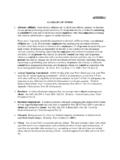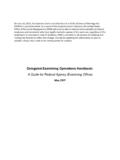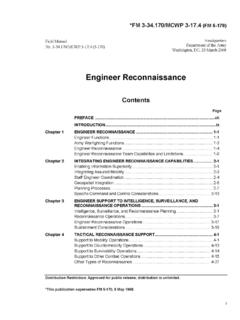Transcription of Appendix C: How to Write a Good Requirement
1 Appendix C: How to Write a good Requirement Use of Correct Terms zz Shall = Requirement zz Will = facts or declaration of purpose zz Should = goal Editorial Checklist Personnel Requirement 1. The Requirement is in the form responsible party shall perform such and such. In other words, use the active, rather than the passive voice. A Requirement must state who shall (do, perform, provide, weigh, or other verb) fol- lowed by a description of what must be performed. Product Requirement 1. The Requirement is in the form product ABC shall XYZ. A Requirement must state The product shall (do, per- form, provide, weigh, or other verb) followed by a description of what must be done.
2 2. The Requirement uses consistent terminology to refer to the product and its lower level entities. 3. Complete with tolerances for qualitative/performance values ( , less than, greater than or equal to, plus or minus, 3 sigma root sum squares). 4. Is the Requirement free of implementation? ( requirements should state WHAT is needed, NOT HOW to provide it; , state the problem not the solution. Ask, Why do you need the Requirement ? The answer may point to the real Requirement .). 5. Free of descriptions of operations? (Is this a need the product must satisfy or an activity involving the product?)
3 Sen- tences like The operator shall are almost always operational statements not requirements .). Example Product requirements zz The system shall operate at a power level of . zz The software shall acquire data from the . zz The structure shall withstand loads of . zz The hardware shall have a mass of . General Goodness Checklist 1. The Requirement is grammatically correct. 2. The Requirement is free of typos, misspellings, and punctuation errors. 3. The Requirement complies with the project's template and style rules. 4. The Requirement is stated positively (as opposed to negatively, , shall not ).
4 5. The use of To Be Determined (TBD) values should be minimized. It is better to use a best estimate for a value and mark it To Be Resolved (TBR) with the rationale along with what must be done to eliminate the TBR, who is responsible for its elimination, and by when it must be eliminated. 6. The Requirement is accompanied by an intelligible rationale, including any assumptions. Can you validate (concur with) the assumptions? Assumptions must be confirmed before baselining. 7. The Requirement is located in the proper section of the document ( , not in an Appendix ).
5 NASA Systems Engineering Handbook 279. Appendix C: How to Write a good Requirement requirements Validation Checklist Clarity 1. Are the requirements clear and unambiguous? (Are all aspects of the Requirement understandable and not subject to misinterpretation? Is the Requirement free from indefinite pronouns (this, these) and ambiguous terms ( , as appropriate, etc., and/or, but not limited to )?). 2. Are the requirements concise and simple? 3. Do the requirements express only one thought per Requirement statement, a standalone statement as opposed to multiple requirements in a single statement, or a paragraph that contains both requirements and rationale?
6 4. Does the Requirement statement have one subject and one predicate? Completeness 1. Are requirements stated as completely as possible? Have all incomplete requirements been captured as TBDs or TBRs and a complete listing of them maintained with the requirements ? 2. Are any requirements missing? For example have any of the following requirements areas been overlooked: func- tional, performance, interface, environment (development, manufacturing, test, transport, storage, operations), facility (manufacturing, test, storage, operations), transportation (among areas for manufacturing, assembling, de- livery points, within storage facilities, loading), training, personnel, operability, safety, security, appearance and physical characteristics, and design.
7 3. Have all assumptions been explicitly stated? Compliance 1. Are all requirements at the correct level ( , system, segment, element, subsystem)? 2. Are requirements free of implementation specifics? ( requirements should state what is needed, not how to provide it.). 3. Are requirements free of descriptions of operations? (Don't mix operation with requirements : update the ConOps instead.). Consistency 1. Are the requirements stated consistently without contradicting themselves or the requirements of related sys- tems? 2. Is the terminology consistent with the user and sponsor's terminology?
8 With the project glossary? 3. Is the terminology consistently used through out the document? 4. Are the key terms included in the project's glossary? Traceability 1. Are all requirements needed? Is each Requirement necessary to meet the parent Requirement ? Is each Requirement a needed function or characteristic? Distinguish between needs and wants. If it is not necessary, it is not a require- ment. Ask, What is the worst that could happen if the Requirement was not included? . 2. Are all requirements (functions, structures, and constraints) bidirectionally traceable to higher level requirements or mission or system-of-interest scope ( , need(s), goals, objectives, constraints, or concept of operations)?
9 3. Is each Requirement stated in such a manner that it can be uniquely referenced ( , each Requirement is uniquely numbered) in subordinate documents? Correctness 1. Is each Requirement correct? 2. Is each stated assumption correct? Assumptions must be confirmed before the document can be baselined. 3. Are the requirements technically feasible? 280 NASA Systems Engineering Handbook Appendix C: How to Write a good Requirement Functionality 1. Are all described functions necessary and together sufficient to meet mission and system goals and objectives? Performance 1.
10 Are all required performance specifications and margins listed ( , consider timing, throughput, storage size, la- tency, accuracy and precision)? 2. Is each performance Requirement realistic? 3. Are the tolerances overly tight? Are the tolerances defendable and cost-effective? Ask, What is the worst thing that could happen if the tolerance was doubled or tripled? . Interfaces 1. Are all external interfaces clearly defined? 2. Are all internal interfaces clearly defined? 3. Are all interfaces necessary, sufficient, and consistent with each other? Maintainability 1.





